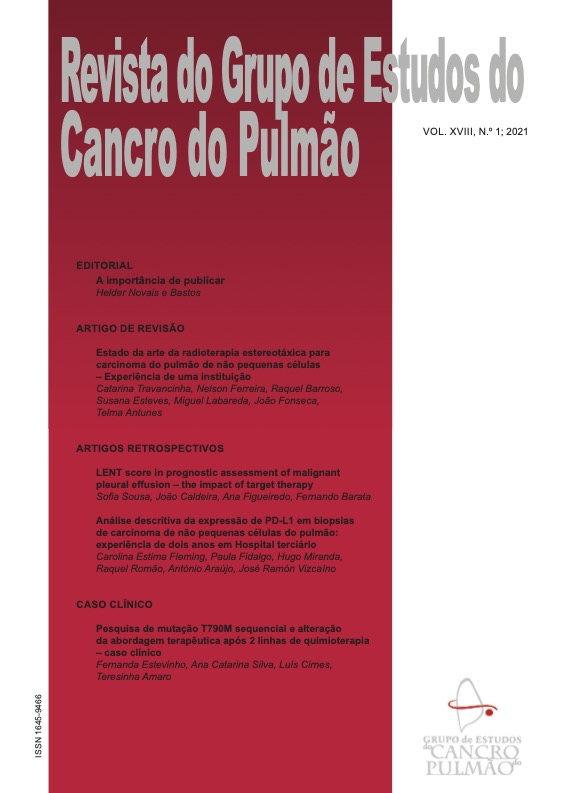LENT score in prognostic assessment of malignant pleural effusion – the impact of target therapy
DOI:
https://doi.org/10.32932/gecp.2021.07.013Keywords:
Malignant pleural effusion, LENT score, AdenocarcinomaAbstract
Introduction: Malignant pleural effusion (MPE) is a common manifestation in patients with advanced lung cancer. The LENT score was developed as a risk stratification system to predict the survival of these patients. However, following the discovery of molecular markers and a new era of personalized therapy, prognostic estimation became a challenging exercise. The aim of this study was to evaluate the performance of LENT score in predicting MPE survival in EGFR and ALK mutated lung adenocarcinoma.Methods: A retrospective single-center study of patients with MPE from lung adenocarcinoma followed between January 2008 to December 2018.
Results: Forty-two patients were included in the study (mean age 76.4 ± 12.6 years, 52% female). Of these patients, 29% exhibited EGFR gene mutation or ALK gene translocation and received tyrosine kinase inhibitor therapy (TKI), in contrast to 71% of patients without identification of mutational factors and receiving conventional chemotherapy. Based on LENT score, in the sub-group treated with conventional chemotherapy, 67% had a moderate-risk category and 33% a high-risk category, with a median overall survival (OS) of 109 (31-406) and 36 (11-77) days, respectively. In the sub-group treated with targeted therapy, 75% were in a moderate-risk category and 25% in a high-risk category with a median OS of 1033 (245-1710) and 238 (27-not available) days, respectively. Patients receiving targeted therapy had a longer survival than patients receiving conventional chemotherapy in all LENT score risk categories (p<0.05).
Conclusions: OS in patients with MPE due to lung adenocarcinoma was similar to that predicted by the LENT score, except for patients with EGFR mutation or ALK translocation. In this subgroup, the LENT score seems to underestimate the prognosis. Although this study has limitations regarding sample size, it does reveal, in the present time, some inaccuracy of the LENT score, demonstrating that it needs to be reviewed and revalidated in view of recent therapeutic advances.
Downloads
References
Agalioti, T., A.D. Giannou, and G.T. Stathopoulos, Pleural involvement in lung cancer. J Thorac Dis, 2015. 7(6): p. 1021-30.
Thomas, J.M. and A.I. Musani, Malignant pleural effusions: a review. Clin Chest Med, 2013. 34(3): p. 459-71.
Heffner, J.E. and J.S. Klein, Recent advances in the diagnosis and management of malignant pleural effusions. Mayo Clin Proc, 2008. 83(2): p. 235-50.
William, W.N., Jr., et al., Revisiting stage IIIB and IV non-small cell lung cancer: analysis of the surveillance, epidemiology, and end results data. Chest, 2009. 136(3): p. 701-709.
Clive, A.O., et al., Predicting survival in malignant pleural effusion: development and validation of the LENT prognostic score. Thorax, 2014. 69(12): p. 1098-104.
Bibby, A.C., et al., ERS/EACTS statement on the management of malignant pleural effusions. European Respiratory Journal, 2018. 52(1): p. 1800349.
Kasapoglu, U.S., et al., Prognostic factors affecting survival in non-small cell lung carcinoma patients with malignant pleural effusions. Clin Respir J, 2016. 10(6): p. 791-799.
Wu, S.-G., et al., Survival of lung adenocarcinoma patients with malignant pleural effusion. European Respiratory Journal, 2013. 41(6): p. 1409-1418.
Clark, J.W. and D.L. Longo, Recent progress in systemic treatment for lung cancer. Curr Opin Pulm Med, 2018. 24(4): p. 355-366.
Takahashi, T., et al., Validation of the LENT score in Japanese sample: The impact of EGFR-TKI. European Respiratory Journal, 2015. 46(suppl 59): p. PA4328.
Abisheganaden, J., et al., An Observational Study Evaluating the Performance of LENT Score in the Selected Population of Malignant Pleural Effusion from Lung Adenocarcinoma in Singapore. Respiration, 2018. 96(4): p. 308-313.
Sugiura, S., et al., Prognostic value of pleural effusion in patients with non-small cell lung cancer. Clin Cancer Res, 1997. 3(1): p. 47-50.
Downloads
Published
Issue
Section
License
Copyright (c) 2025 Author(s) (or their employer(s)) and THORAC 2024

This work is licensed under a Creative Commons Attribution-NonCommercial 4.0 International License.





